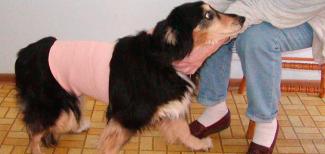You didn’t breed your female during her last heat cycle, yet she acts and looks like she is pregnant. Her nesting instinct has kicked in, and her mammary glands are swollen as though in preparation for lactation. A false pregnancy may be to blame.
“Essentially all dogs that go through estrus, or have a heat cycle, go through a false pregnancy because they undergo the same hormonal changes after estrus whether they are bred or not,” says Margaret V. “Peggy” Root Kustritz, DVM, PhD, DACT, professor of small animal reproduction and associate dean of education at the University of Minnesota College of Veterinary Medicine.
Thus, all intact bitches will potentially show physical and behavioral signs of false pregnancy, also known as pseudopregnacy or pseudocyesis, which occur about two months after estrus. One report indicates that 87 percent of bitches show signs of false pregnancy two or more times in their life while intact.1
Fortunately, most cases of false pregnancy are mild and resolve on their own. “Although all intact females go through these normal hormonal changes, not all exhibit clinical signs of false pregnancy,” says Dr. Root Kustritz, a board-certified reproduction specialist. “No age or breed predisposition is seen with false pregnancy. Some females show signs when they are young that stop as they age, and others do not show signs until they are older.”
High levels of the female sex hormone progesterone are produced during the two-month diestrus period that follows estrus. At the end of diestrus, a sexual dormancy period between cycles, progesterone concentrations in the blood fall rapidly while concentrations of prolactin, a hormone made by the pituitary gland that enables females to produce milk, begin to rise.
“The prolonged high progesterone levels stimulate mammary development and may loosen joints, giving some dogs an abdominal distension as their ribs ‘spring’ apart that mimics a pregnancy appearance,” says Dr. Root Kustritz. “The sudden fall in progesterone and rise in prolactin stimulate milk production and account for the whelping behaviors that are observed in a false pregnancy.”
Essentially anything that causes a fall in progesterone in the blood can lead to false pregnancy. Spay surgery, or ovariohysterectomy, performed when a female is in diestrus can trigger false pregnancy via the removal of the ovaries and progesterone-producing tissue. Dogs treated with progesterone as therapy for skin, behavior and reproductive conditions may show signs of false pregnancy when progesterone treatment is stopped.
“False pregnancy is initially detected when a veterinarian palpates a dog’s abdomen and verifies that the bitch is not truly pregnant,” Dr. Root Kustritz says. “Radiographs provide a definitive diagnosis. Clinical signs are similar to late-term pregnancy, so it is important to confirm that a female is indeed having a false pregnancy even in cases where she was not knowingly bred. A false pregnancy is the only other diagnosis consistent with this history and signs.”
Although mild cases typically resolve in seven to 10 days, dogs having extreme signs may need sedation treatment for aggressive behavior or relief from painful mammary development. “I have had good success wrapping the dog’s mammary area with an elastic bandage and reducing food and water in half for one day to put pressure on the mammary glands,” says Dr. Root Kustritz. “This sends a signal to the brain to stop secretion of prolactin and subsequent milk production. It also protects the mammary glands from trauma and dehydrates the dog a bit, which helps to slow milk production. The last thing you should do is to ‘milk out’ the engorged mammary glands as this signals the body to continue milk production.”
Females having recurring and severe episodes of false pregnancy may require an ovariohysterectomy to prevent future occurrences. “Consult your veterinarian for the best approach for treating an individual dog,” Dr. Root Kustritz advises. “Importantly, it is best to delay spay surgery eight to 10 weeks after estrus to lessen the risk of inducing false pregnancy.”
The good news is that for most females a false pregnancy has minimal impact on their overall health. “Even dogs with a history of overt false pregnancy after estrus are not more prone to infections of the uterus, such as pyometra, than dogs without clinical signs. Importantly, all bitches go through the hormonal changes of false pregnancy, and those that exhibit clinical signs are not less fertile than those that do not show signs.”
1 Janssens LA. Treatment of Pseudopregnancy with Bromocriptin, an Ergot Alkaloid. Veterinary Research. 1986;119(8):172-174.
(Box)
Signs of Canine False Pregnancy
Behavioral Signs
- Nesting behaviors
- Affectionate and protective of toys
- Restlessness
- Abdominal licking
- Decreased activity
Clinical Signs
- Weight gain and abdominal swelling
- Mammary enlargement and lactation
- Anorexia

